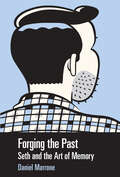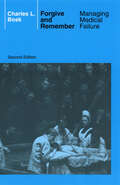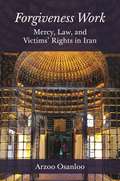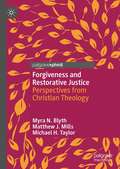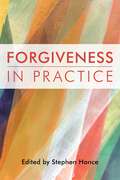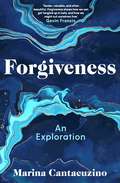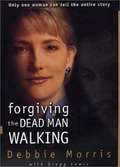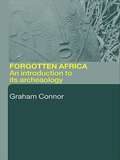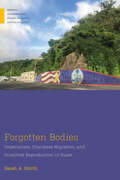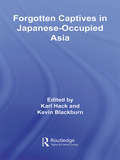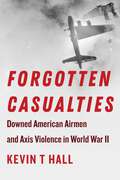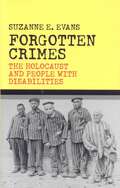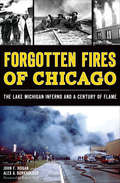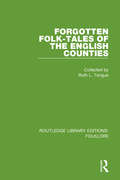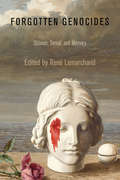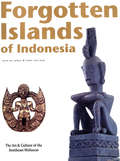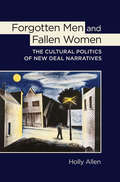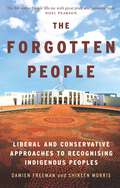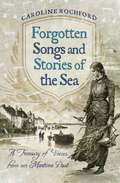- Table View
- List View
Forging the Past: Seth and the Art of Memory (Tom Inge Series on Comics Artists)
by Daniel MarroneAt once familiar and hard to place, the work of acclaimed Canadian cartoonist Seth evokes a world that no longer exists—and perhaps never existed, except in the panels of long-forgotten comics. Seth's distinctive drawing style strikingly recalls a bygone era of cartooning, an apt vehicle for melancholy, gently ironic narratives that depict the grip of the past on the present. Even when he appears to look to the past, however, Seth (born Gregory Gallant) is constantly pushing the medium of comics forward with sophisticated work that often incorporates metafiction, parody, and formal experimentation. Forging the Past offers a comprehensive account of this work and the complex interventions it makes into the past. Moving beyond common notions of nostalgia, Daniel Marrone explores the various ways in which Seth's comics induce readers to participate in forging histories and memories. Marrone discusses collecting, Canadian identity, New Yorker cartoons, authenticity, artifice, and ambiguity—all within the context of comics' unique structure and texture. Seth's comics are suffused with longing for the past, but on close examination this longing is revealed to be deeply ambivalent, ironic, and self-aware. Marrone undertakes the most thorough, sustained investigation of Seth's work to date, while advancing a broader argument about how comics operate as a literary medium. Included as an appendix is a substantial interview, conducted by the author, in which Seth candidly discusses his work, his peers, and his influences.
Forgive and Remember: Managing Medical Failure
by Charles L. BoskThe landmark study of how medical errors are managed among surgeons and other hospital staff—now in an updated edition with a new preface and epilogue.When it was first published, Forgive and Remember offered groundbreaking insight into the training and lives of young surgeons. It quickly emerged as the definitive sociological study on the subject. While medical errors are both inevitable and potentially devastating, Bosk found that they could be forgiven—as long as they were remembered and never repeated.In this second edition, Bosk reflects more than twenty years later on how things have changed, both in the medical profession and in sociology. With an extensive new preface, epilogue, and appendix by the author, this updated edition of Forgive and Remember is as timely as ever.
Forgiveness Work: Mercy, Law, and Victims' Rights in Iran
by Arzoo OsanlooA remarkable look at an understudied feature of the Iranian justice system, where forgiveness is as much a right of victims as retributionIran’s criminal courts are notorious for meting out severe sentences—according to Amnesty International, the country has the world’s highest rate of capital punishment per capita. Less known to outside observers, however, is the Iranian criminal code’s recognition of forgiveness, where victims of violent crimes, or the families of murder victims, can request the state to forgo punishing the criminal. Forgiveness Work shows that in the Iranian justice system, forbearance is as much a right of victims as retribution. Drawing on extended interviews and first-hand observations of more than eighty murder trials, Arzoo Osanloo explores why some families of victims forgive perpetrators and how a wide array of individuals contribute to the fraught business of negotiating reconciliation.Based on Qur’anic principles, Iran’s criminal codes encourage mercy and compel judicial officials to help parties reach a settlement. As no formal regulations exist to guide those involved, an informal cottage industry has grown around forgiveness advocacy. Interested parties—including attorneys, judges, social workers, the families of victims and perpetrators, and even performing artists—intervene in cases, drawing from such sources as scripture, ritual, and art to stir feelings of forgiveness. These actors forge new and sometimes conflicting strategies to secure forbearance, and some aim to reform social attitudes and laws on capital punishment.Forgiveness Work examines how an Islamic victim-centered approach to justice sheds light on the conditions of mercy.
Forgiveness and Restorative Justice: Perspectives from Christian Theology
by Myra N. Blyth Matthew J. Mills Michael H. TaylorThe meaning of ‘forgiveness’ and its role within restorative justice are highly contested. This book offers analysis from practical and academic perspectives within Christian theology, against a rich canvas of related concepts, including victimhood, sin, love, and vulnerability. Critical friends of restorative justice, the authors argue that forgiveness – whether as journey or act, unilateral or mutual, conditional or unconditional – is necessary to achieving a fully restorative resolution to acts of harm. They also suggest that Christianity, with its meaning-giving metanarrative of restoration, and preference for communitarian approaches to justice, may have epistemic value for evaluating and even deepening the theory and practice of restorative justice.
Forgiveness in Practice
by Howard Cooper Chris Cook Deborah Bowman Gwen Adshead Richard Carter Graham Spencer Marina Cantacuzino Christiane Sanderson Robin Shohet Steve Nolan Marian Liebmann Stephen Cherry Liz Gulliford Stephen Hance Anthony Bash Reza Shah-Kazemi Vajragupta Jesse Butler Meadows Honor Rhodes Amanda Boorman Lord Alderdice Wendy DossettForgiveness has often viewed as a religious obligation but is increasingly being advocated as a means of healing, release and promoting wellbeing. Forgiveness is variously viewed as a duty, virtue or cure, but when it comes to practising forgiveness in real life we find it is always caught up in the complexity of the situation. This book shines a light on how we tend to think about forgiveness in practice, including examples from social work, family therapy, chaplaincy and criminal justice.The book contains many different perspectives on how we think about forgiveness, including overviews of four major religions and reflections from those working in the healing professions. Without advocating a particular approach this book raises important questions around self-forgiveness and forgiving institutions and encourages the reader to think again about forgiveness and how it impacts, challenges and transforms relationships.
Forgiveness: An Exploration
by Marina CantacuzinoI forgive you. Three simple words behind which sits an intriguing and complex concept. These words can be used to absolve a meaningless squabble, or said to someone who has caused you great harm. They can liberate you from guilt, or consciously place blame on your shoulders. Forgiveness can often be perceived as saccharine and overtly religious, something just for the spiritually superior or mentally strong. But really it is a gritty, risky concept that is so often relevant to our ordinary everyday lives. Forgiveness explores the subject from every angle, coming from a place of enquiry rather than persuasion, presenting it as an offering, never a prescription. Marina Cantacuzino seeks to investigate, unpick and debate the limits and possibilities of forgiveness – in our relationships, for our physical and mental wellbeing, how it plays out in international politics and within the criminal justice system, and where it intersects with religious faith. Cantacuzino speaks to people across the globe who have considered forgiveness in different forms and circumstances. She talks to a survivor of Auschwitz; to someone who accidentally killed a friend; to people who have lost loved ones in acts of violence; to a former combatant in The Troubles as well as to the daughter of someone he murdered. Through these real stories, expert opinion and the author&’s experience from two decades working in this field, the reader gets to better understand what forgiveness is and what it most definitely isn&’t, how it can be an important element in breaking the cycle of suffering, and ultimately how it might help transform fractured relationships and mend broken hearts.
Forgiving The Dead Man Walking: Only One Woman Can Tell The Entire Story
by Debbie Morris Gregg LewisThis is the story of the kidnapping of a couple from the "riverfront." The author is repeatedly raped, and her boyfriend is shot in the head and left for dead. The author is eventually released. This is the story not only of the kidnapping but also of the aftermath of the abduction and how the author eventually over many years gets her "life back."
Forgotten Africa: An Introduction to its Archaeology
by Graham ConnahForgotten Africa introduces the general reader and beginning student to Africa's past, emphasizing those aspects only known or best known from archaeological and related evidence. It covers four million years of history across the continent, examining important aspects of Africa's momentous human story. Graham Connah is concerned to raise public awareness, both inside and outside Africa, to this frequently overlooked and often forgotten subject. Forgotten Africa examines: * human origins,* the material culture of hunter gatherers* the beginnings of African farming, the development of metallurgy* the emergence of distinctive artistic traditions* the growth of cities and states* the expansion of trading networks * the impact of European and other external contacts. The result is a fascinating and important story told in a straightforward and readable manner.
Forgotten Bodies: Imperialism, Chuukese Migration, and Stratified Reproduction in Guam (Medical Anthropology)
by Sarah A. SmithWomen from Chuuk, Federated States of Micronesia, who migrate to Guam, a U.S. territory, suffer disproportionately poor reproductive health outcomes. Though their access to the United States is unusually easy, through a unique migration agreement, it keeps them in a perpetual liminal state as nonimmigrants, who never fully belong as part of the United States Chuukese women move to Guam, sometimes with their families but sometimes alone, in search of a better life: for jobs, for the education system, or to access safe health care. Yet, the imperial system they encounter creates underlying conditions that greatly and disproportionately impact their ability to succeed and thrive, negatively impacting their reproductive health. Through clinical and community ethnography, Sarah A. Smith illuminates the way this system stratifies women’s reproduction at structural, social, and individual levels. Readers can visualize how U.S. imperialist policies of benign neglect control the body politic, change the social body, and render individual bodies vulnerable in the twenty-first century but also how people resist.
Forgotten Captives in Japanese-Occupied Asia (Routledge Studies in the Modern History of Asia #10)
by Kevin Blackburn Karl HackExperiences of captivity in Japanese-occupied Asia varied enormously. Some prisoners of war (POWs) were sent to work in Japan, others to toil on the ‘Death Railway’ between Burma and Thailand. Some camps had death rates below 1 per cent, others of over 20 per cent. While POWs were deployed far and wide as a captive labour force, civilian internees were generally detained locally. This book explores differences in how captivity was experienced between 1941 and 1945, and has been remembered since: differences due to geography and logistics, to policies and personalities, and marked by nationality, age, class, gender and combatant status. Part One has at least one chapter for each ‘National Memory’, Australian, British, Canadian, Dutch, Indian and American. Part Two moves on to forgotten captivities. It covers women, children, camp guards, internee experiences upon the end of the war, and local heroines who fought back. By juxtaposing such a wide variety of captivity experiences – differentiated both by category of captive and by approach - this book transcends place, to become a collection about captivity as a category. It will interest scholars working on the Asia-Pacific War, on captivities in general, and on the individual histories of the countries and groups covered.
Forgotten Casualties: Downed American Airmen and Axis Violence in World War II (World War II: The Global, Human, and Ethical Dimension)
by Kevin T HallSheds new light on the mistreatment of downed airmen during World War II and the overall relationship between the air war and state-sponsored violence.Throughout the vast expanse of the Pacific, the remoteness of Southeast Asia, and the rural and urban communities in Nazi-occupied Europe, more than 120,000 American airmen were shot down over enemy territory during World War II, thousands of whom were mistreated and executed. The perpetrators were not just solely fanatical soldiers or Nazi zealots but also ordinary civilians triggered by the death and devastation inflicted by the war. In Forgotten Casualties, author Kevin T Hall examines Axis violence inflicted on downed Allied airmen during this global war.Compared with all other armed conflicts, World War II exhibited the most widespread and ruthless violence committed against airmen. Flyers were deemed guilty because of their association with the Allied air forces, and their fate remained in the hands of their often-hostile captors. Axis citizens angered by the devastation inflicted by the war, along with the regimes’ consent and often encouragement of citizens to take matters into their own hands, resulted in thousands of Allied flyers’ being mistreated and executed by enraged civilians. Written to help advance the relatively limited discourse on the mistreatment against flyers in World War II, Forgotten Casualties is the first book to analyze the Axis violence committed against Allied airmen in a comparative, international perspective. Effectively comparing and contrasting the treatment of POWs in Germany with that of their counterparts in Japan, Hall’s thorough analysis of rarely seen primary and secondary sources sheds new light on the largely overlooked complex relationship among the air war, propaganda, the role of civilians, and state-sponsored terror during the radicalized conflict. Sources include postwar trial testimonies, Missing Air Crew Reports (MACR), Escape and Evasion reports, perpetrators’ explanations and rationalizations for their actions, extensive judicial sources, transcripts of court proceedings, autopsy reports, appeals for clemency, and justifications for verdicts.Drawing heavily on airmen’s personal accounts and the testimonies of both witnesses and perpetrators from the postwar crimes trials, Forgotten Casualties offers a new narrative of this largely overlooked aspect of Axis violence.
Forgotten Crimes: The Holocaust And People With Disabilities
by Suzanne E. EvansBetween 1939 and 1945 the Nazi regime systematically murdered hundreds of thousands of children and adults with disabilities as part of its "euthanasia" programs. These programs were designed to eliminate all persons with disabilities who, according to Nazi ideology, threatened the health and purity of the German race. Forgotten Crimes explores the development and workings of this nightmarish process, a relatively neglected aspect of the Holocaust. Suzanne Evans's account draws on the rich historical record as well as scores of exclusive interviews with disabled Holocaust survivors. It begins with a description of the Nazis' Children's Killing Program, in which tens of thousands of children with mental and physical disabilities were murdered by their physicians, usually by starvation or lethal injection. The book goes on to recount the T4 euthanasia program, in which adults with disabilities were disposed of in six official centers, and the development of the Sterilization Law that allowed the forced sterilization of at least a half-million young adults with disabilities. Ms. Evans provides portraits of the perpetrators and accomplices of the killing programs, and investigates the curious role of Switzerland's rarely discussed exclusionary immigration and racially eugenic policies. Finally, Forgotten Crimes notes the inescapable implications of these Nazi medical practices for our present-day controversies over eugenics, euthanasia, genetic engineering, medical experimentation, and rationed health care.
Forgotten Fires of Chicago: The Lake Michigan Inferno and a Century of Flame (Disaster Ser.)
by John F. Hogan Alex A. BurkholderA historical journey through the city&’s catastrophic fires, and the stories of the heroes who fought them. Chicago&’s war against cinder, flame, and smoke did not end with the Great Fire of 1871. In 1909, fire ripped through the dynamite room of a staging facility a mile and half off the Lake Michigan shoreline, transforming the pipe-laying operation into a raging inferno. During the World&’s Columbian Exposition, thousands of fairgoers watched in horror as twelve firefighters were trapped in a blazing ice warehouse. An opera-goer left a smoking bomb under his seat at the Auditorium Theater in 1917. And the newly invented smoke ejector arrived too late to save firemen and laborers cut off in a sewer in 1931. Join John F. Hogan and Alex A. Burkholder for the history of these forgotten fires—and those who responded to them. &“A must-read not only for first responders but also all history buffs, especially those interested in Chicago history.&” —Robert Hoff, retired fire commissioner, Chicago Fire Department, from the foreword
Forgotten Folk-tales of the English Counties (Routledge Library Editions: Folklore Ser.)
by Ruth TongueIn this book, first published in 1970, Ruth L. Tongue has collected a number of county folk tales recorded by her from childhood onwards, from old people, village children and farm round-the-fire sessions. Many of the beliefs embodied in the gipsy and witchcraft tales are still in practice today among the travelling people and locally ‘gifted’ healers. The tales reveal a good deal of fairy lore, some tree lore, including ghostly trees like Crooker, and the ‘uncanny’ Black Dog makes his appearance in more than one tale. The collection includes several of the long fireside tales which would be told on succeeding evenings on winter nights round the kitchen fire, and rhozzums from various localities.
Forgotten Genocides
by Rene LemarchandUnlike the Holocaust, Rwanda, Cambodia, or Armenia, scant attention has been paid to the human tragedies analyzed in this book. From German Southwest Africa (now Namibia), Burundi, and eastern Congo to Tasmania, Tibet, and Kurdistan, from the mass killings of the Roms by the Nazis to the extermination of the Assyrians in Ottoman Turkey, the mind reels when confronted with the inhuman acts that have been consigned to oblivion.Forgotten Genocides: Oblivion, Denial, and Memory gathers eight essays about genocidal conflicts that are unremembered and, as a consequence, understudied. The contributors, scholars in political science, anthropology, history, and other fields, seek to restore these mass killings to the place they deserve in the public consciousness. Remembrance of long forgotten crimes is not the volume's only purpose--equally significant are the rich quarry of empirical data offered in each chapter, the theoretical insights provided, and the comparative perspectives suggested for the analysis of genocidal phenomena. While each genocide is unique in its circumstances and motives, the essays in this volume explain that deliberate concealment and manipulation of the facts by the perpetrators are more often the rule than the exception, and that memory often tends to distort the past and blame the victims while exonerating the killers.Although the cases discussed here are but a sample of a litany going back to biblical times, Forgotten Genocides offers an important examination of the diversity of contexts out of which repeatedly emerge the same hideous realities.
Forgotten Girls: Stories of Hope and Courage
by Kay Marshall Strom Michele Rickett2014 Readers' Choice Award Winner
Forgotten Islands of Indonesia
by Joss Van Dijk Nico DejongeThis beautiful book contains over 170 unique photographs and pictures of one of the most interesting but least well known cultures in the Indonesian Archipelago.The traditional art of Maluku Tenggara, the Southeast Moluccas, is among the most sophisticated and expressive in the world. Simple tools were used to create masterpieces in wood, stone, textiles and precious metals, while the plaited work and earthenware of these islands are also of the very highest quality.the colonial period plunged the region into hopeless isolation. During the harsh rule of the Dutch many traditional woks of art, especially ancestor statues, were destroyed. Later, collectors stripped the islands of their masterpieces and the culture of Maluka Tenggara was forgotten.Forgotten Islands of Indonesia presents a unique survey of the finest examples of Southeast Moluccan art. This volume contains many photographs and descriptions which have never before been published. Set against the cultural background and supplemented by rare photographs taken in the field, the material culture of Maluku Tenggara, which is regarded as one of the most fascinating areas of Indonesia, is presented here comprehensively for the first time.
Forgotten Islands of Indonesia
by Joss Van Dijk Nico DejongeThis beautiful book contains over 170 unique photographs and pictures of one of the most interesting but least well known cultures in the Indonesian Archipelago.The traditional art of Maluku Tenggara, the Southeast Moluccas, is among the most sophisticated and expressive in the world. Simple tools were used to create masterpieces in wood, stone, textiles and precious metals, while the plaited work and earthenware of these islands are also of the very highest quality.the colonial period plunged the region into hopeless isolation. During the harsh rule of the Dutch many traditional woks of art, especially ancestor statues, were destroyed. Later, collectors stripped the islands of their masterpieces and the culture of Maluka Tenggara was forgotten.Forgotten Islands of Indonesia presents a unique survey of the finest examples of Southeast Moluccan art. This volume contains many photographs and descriptions which have never before been published. Set against the cultural background and supplemented by rare photographs taken in the field, the material culture of Maluku Tenggara, which is regarded as one of the most fascinating areas of Indonesia, is presented here comprehensively for the first time.
Forgotten Islands of Indonesia
by Joss Van Dijk Nico DejongeThis beautiful book contains over 170 unique photographs and pictures of one of the most interesting but least well known cultures in the Indonesian Archipelago.The traditional art of Maluku Tenggara, the Southeast Moluccas, is among the most sophisticated and expressive in the world. Simple tools were used to create masterpieces in wood, stone, textiles and precious metals, while the plaited work and earthenware of these islands are also of the very highest quality.the colonial period plunged the region into hopeless isolation. During the harsh rule of the Dutch many traditional woks of art, especially ancestor statues, were destroyed. Later, collectors stripped the islands of their masterpieces and the culture of Maluka Tenggara was forgotten.Forgotten Islands of Indonesia presents a unique survey of the finest examples of Southeast Moluccan art. This volume contains many photographs and descriptions which have never before been published. Set against the cultural background and supplemented by rare photographs taken in the field, the material culture of Maluku Tenggara, which is regarded as one of the most fascinating areas of Indonesia, is presented here comprehensively for the first time.
Forgotten Islands of Indonesia: The Art & Culture of the Southeast Moluccas
by Joss Van Dijk Nico DejongeThis beautiful book contains fascinating text and over 170 unique photographs of one of the most interesting but least well known cultures in the Indonesian Archipelago.The traditional art of Maluku Tenggara, the Southeast Moluccas, is among the most sophisticated and expressive in the world. Simple tools were used to create masterpieces in wood, stone, textiles and precious metals, while the plaited work and earthenware of these islands are also of the very highest quality.the colonial period plunged the region into hopeless isolation. During the harsh rule of the Dutch many traditional woks of art, especially ancestor statues, were destroyed. Later, collectors stripped the islands of their masterpieces and the culture of Maluka Tenggara was forgotten.Forgotten Islands of Indonesia presents a unique survey of the finest examples of Southeast Moluccan art. This volume contains many photographs and descriptions which have never before been published. Set against the cultural background and supplemented by rare photographs taken in the field, the material culture of Maluku Tenggara, which is regarded as one of the most fascinating areas of Indonesia, is presented here comprehensively for the first time.
Forgotten Men and Fallen Women: The Cultural Politics of New Deal Narratives
by Holly AllenDuring the Great Depression and into the war years, the Roosevelt administration sought to transform the political, institutional, and social contours of the United States. One result of the New Deal was the emergence and deployment of a novel set of narratives—reflected in social scientific case studies, government documents, and popular media—meant to reorient relationships among gender, race, sexuality, and national political power. In Forgotten Men and Fallen Women, Holly Allen focuses on the interplay of popular and official narratives of forgotten manhood, fallen womanhood, and other social and moral archetypes. In doing so, she explores how federal officials used stories of collective civic identity to enlist popular support for the expansive New Deal state and, later, for the war effort.These stories, she argues, had practical consequences for federal relief politics. The “forgotten man,” identified by Roosevelt in a fireside chat in 1932, for instance, was a compelling figure of collective civic identity and the counterpart to the white, male breadwinner who was the prime beneficiary of New Deal relief programs. He was also associated with women who were blamed either for not supporting their husbands and family at all (owing to laziness, shrewishness, or infidelity) or for supporting them too well by taking their husbands’ jobs, rather than staying at home and allowing the men to work.During World War II, Allen finds, federal policies and programs continued to be shaped by specific gendered stories—most centrally, the story of the heroic white civilian defender, which animated the Office of Civilian Defense, and the story of the sacrificial Nisei (Japanese-American) soldier, which was used by the War Relocation Authority. The Roosevelt administration’s engagement with such widely circulating narratives, Allen concludes, highlights the affective dimensions of U.S. citizenship and state formation.
Forgotten Patriots: The Untold Story of American Prisoners During the Revolutionary War
by Edwin G. BurrowsBetween 1775 and 1783, some 200,000 Americans took up arms against the British Crown. Just over 6,800 of those men died in battle. About 25,000 became prisoners of war, most of them confined in New York City under conditions so atrocious that they perished by the thousands. Evidence suggests that at least 17,500 Americans may have died in these prisons--more than twice the number to die on the battlefield. It was in New York, not Boston or Philadelphia, where most Americans gave their lives for the cause of independence. New York City became the jailhouse of the American Revolution because it was the principal base of the Crown’s military operations. Beginning with the bumper crop of American captives taken during the 1776 invasion of New York, captured Americans were stuffed into a hastily assembled collection of public buildings, sugar houses, and prison ships. The prisoners were shockingly overcrowded and chronically underfed--those who escaped alive told of comrades so hungry they ate their own clothes and shoes. Despite the extraordinary number of lives lost, Forgotten Patriots is the first-ever account of what took place in these hell-holes. The result is a unique perspective on the Revolutionary War as well as a sobering commentary on how Americans have remembered our struggle for independence--and how much we have forgotten.
Forgotten People: Liberal and conservative approaches to recognising indigenous peoples
by Damien Freeman Shireen MorrisThe Forgotten People challenges the assumption that constitutional recognition of indigenous Australians is a project of the left in Australia.It demonstrates that there may be a set of reforms that can achieve the change sought by indigenous leaders, while addressing the critical concerns of constitutional conservatives and classical liberals. More than that, this collection illustrates the genuine goodwill that many Australians, including Major General Michael Jeffery, Cardinal George Pell, Chris Kenny and Malcolm Mackerras, share for achieving indigenous recognition that is practically useful and symbolically powerful.
Forgotten Readers: Recovering the Lost History of African American Literary Societies
by Elizabeth MchenryOver the past decade the popularity of black writers including E. Lynn Harris and Terry McMillan has been hailed as an indication that an active African American reading public has come into being. Yet this is not a new trend; there is a vibrant history of African American literacy, literary associations, and book clubs. Forgotten Readers reveals that neglected past, looking at the reading practices of free blacks in the antebellum north and among African Americans following the Civil War. It places the black upper and middle classes within American literary history, illustrating how they used reading and literary conversation as a means to assert their civic identities and intervene in the political and literary cultures of the United States from which they were otherwise excluded. Forgotten Readers expands our definition of literacy and urges us to think of literature as broadly as it was conceived of in the nineteenth century. Elizabeth McHenry delves into archival sources, including the records of past literary societies and the unpublished writings of their members. She examines particular literary associations, including the Saturday Nighters of Washington, D. C. , whose members included Jean Toomer and Georgia Douglas Johnson. She shows how black literary societies developed, their relationship to the black press, and the ways that African American women's clubs--which flourished during the 1890s--encouraged literary activity. In an epilogue, McHenry connects this rich tradition of African American interest in books, reading, and literary conversation to contemporary literary phenomena such as Oprah Winfrey's book club.
Forgotten Songs and Stories of the Sea: A Treasury of Voices from our Maritime Past
by Caroline RochfordA collection of fascinating folklore and maritime trivia about pirates, explorers, naval battles, shipwrecks, sea monsters, and more. Stirring tales of heroism at sea have been ingrained in the annals of maritime history from time immemorial. Christopher Columbus&’s discovery of the New World, Queen Elizabeth I&’s defeat of the Spanish Armada, and Horatio Nelson&’s victory at Trafalgar are just some of Britain&’s most memorable naval triumphs. But what about the lesser-known tales from its seafaring past? The Victorian who invented a swimming machine in order to cross the English Channel; the capture of a real-life mermaid; the lost pirate treasure of Alborn; the ghost of a murdered sailor who still haunts the streets of Portsmouth; and the daring explorers who vanished into the blue yonder, leaving behind nothing but a cryptic message in a champagne bottle—these are just some of the quirky naval stories that have been chronicled in verse and archived in newspaper clippings, and forgotten with the passage of time. Historian and genealogist Caroline Rochford has compiled 200 traditional songs and stories into this book, which offers an exciting, entertaining and eye-opening glimpse into a long-lost maritime past.
